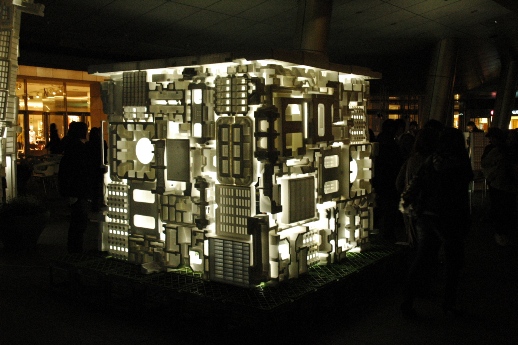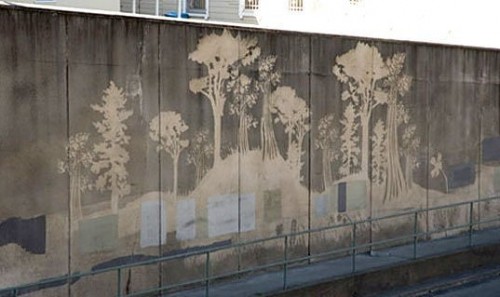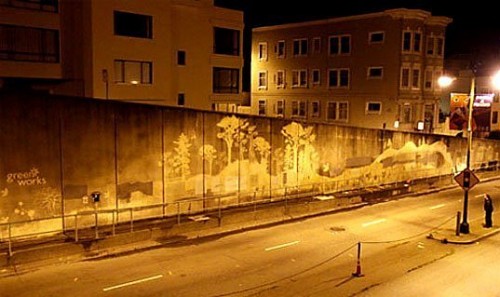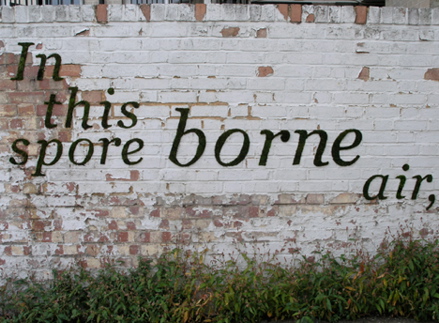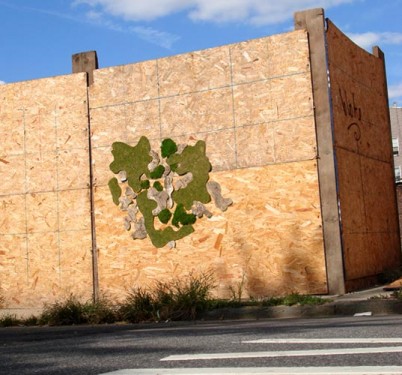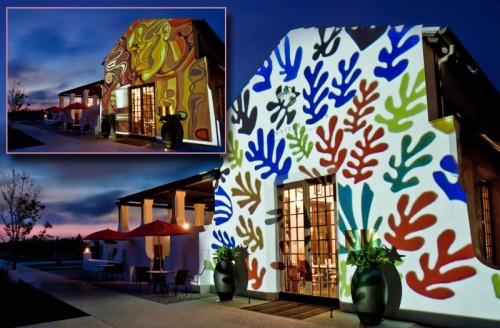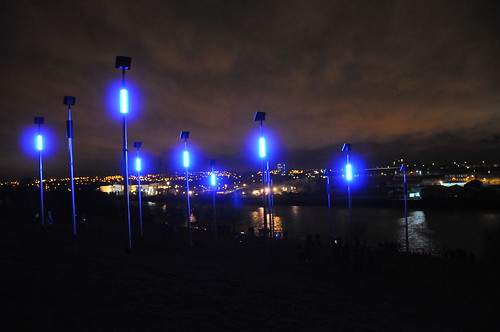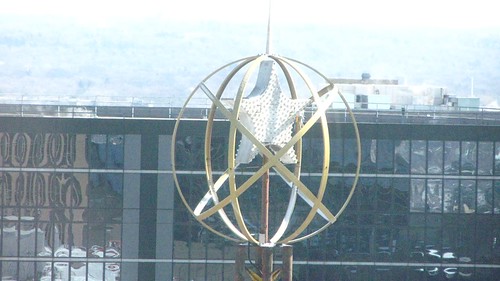If you have a few minutes, click through Thomas Hawk’s, flickr set “Graffiti, Stencils and Public Murals and Art.”
What’s up in Milwaukee?
On April 1, Mary Louise Schmacher wrote an article in the Milwaukee Wisconsin Journal Sentinel titled “Why Milwaukee is ready for Zweig’s public art.” She begins the article:
“Here’s hoping Milwaukee has finally found a public art project that it can embrace. Janet Zweig’s proposal for E. Wisconsin Ave., which goes before the Common Council’s Public Works Committee this morning at 9 a.m. is a quiet, poetic work that will delight and surprise pedestrians.
“Zweig defines the term ‘public’ in ‘public art’ in entirely new and truly meaningful ways. Instead of creating committees that get nominal community “input”, that have token artists offer opinions before commissioning static works of forgettable art, as has been done repeatedly here, Zweig’s art engages Milwaukee in a thoughtful and genuine way.”
Read the full article.
Later that same day, Schumacher blogged: “Janet Zweig’s public art project in trouble.” In detailing what happened at the meeting of the Public Works Committee of the Common Council, Schumacher quoted some of the responses at the meeting.
“Ald. Robert G. Donovan left the room, saying, ‘I refuse to have my name attached to something as ridiculous as that.’
“Aldermen Joe Dudzik and Willie C. Wade also objected to the ‘old school’ technology, signs similar to those used in train stations until a few decades ago, which would be used to make animations.”
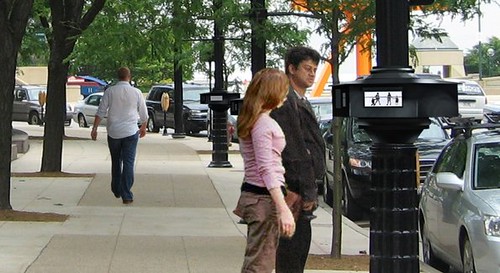
Prototype of Zweig’s proposed project.
Dudzik and Wade said, according to Schumacher in a related article:
“‘We are taking about a design that holds us back or indicates that we are stuck in the past,’ said vice chairman Ald. Joe Dudzik, referring to the old-fashioned signs that Zweig uses to create short animations.
“‘I am just not feeling it,’ said Ald. Willie Wade. ‘But then I wouldn’t pay 50 cents for the Mona Lisa.'”
I’m not familiar with the situation on the ground, and it’s hard to imagine why a 3-year, $300,000 project appears to have caught the Council by suprise with only one speaker in support of the proposal. Nevertheless, I’m a fan of both Zweig’s work and the “old-fashioned” technology she proposes to use – wonderfully, I think.

When I first saw Zweig’s Impersonator – not in person, unfortunately – I was captivated. The flip technology is best known for its use in transportation hubs, such as train stations and airports, and it is this association that makes it like a sign post for the imagination. What if I was going to Lille today? Where exactly is Strasbourg? How long would it take to get out of town to Chicago?
Janet Zweig, Professor Obsessive and His Two Compulsions from Steve Dietz on Vimeo.
In Milwaukee, Zweig is proposing a series of animations using the flip signs, as in the example above. I think it’s interesting that the council members apparently complained about the low tech nature of this proposal. For me, it is evocative of the invention of cinema with devices such as the zoetrope and conjures an entire cinema paradiso of imaginative pleasure. When ZER01 presented Peter Hudson’s Homouroboros zoetrope at the 2nd 01SJ Biennial, no one complained about how low tech it was. It was a magical experience.
The geneaology of Zweig’s Milwaukee proposal is from Impersonator (2002), through Carrying On (2004), a 1200 foot frieze at the Prince Street station of the New York subway, which celebrates the significance and individuality of the citizens of New York. In Milwaukee, she proposes to marry the graphic style of Carrying On, with the technology of Impersonator in a kind of homespun, so to speak, cel animation, similar to this unrealized proposal for an airport baggage claim area. Of course, I’d much rather be reading sponsored advertising on a “high tech” screen while I’m waiting for my luggage to not appear after a long flight home from Lille or Strausbourg. . . .
By the way, Zweig’s Impersonator made the top 5 “high tech” public artworks on CNET along with some other amazing projects.
And the internationally renowned artist duo, Thomson + Craighead use the same vendor – one of the few, if not the only remaining manufacturer of this technology anywhere in the world – to create a highly-praised work, Beacon, which has been shown at London’s prestigious British Film Institute and FACT: the Foundation for Art and Creative Technology.
But apparently it’s too low tech for Milwaukee. Or not?
Purls of wisdom
There has been a slew of radical textile projects of late, it seems, although there is always a longer history than we realize:

Germaine Koh’s Knitwork, which she describes as a lifeling project, began in 1992. Periodically, Germaine makes an appointment with the registrar at the Art Gallery of Ontario to knit one purl two, adding to her work. More recently, see Cat Mazza’s microRevolt; Rachel Beth Egenhoefer’s KNiiTTiiNG – knitting for the Ninetendo Wii and virtual knitting; which reminds me of Stephanie Rothenberg and Jeff Crouse’s Invisible Threads.
And there are many, many other projects, but spurred by Forecaster2’s Overview of Nouveau Graffiti, I want to call attention to the blog on Etsy about Magda Sayeg’s Knitta. The intro about “tomasons” is worth quoting:
“‘The apartment I moved into has a tomason,’ said Rachel, my friend Tom’s girlfriend. ‘A what?’ I asked, thinking it was some sort of poltergeist. ‘It’s this old, weird metal thing sticking out of the wall,’ Rachel explained. ‘I’m not sure, but I think it used to be a fixture when there were gas lights.’ ‘A tomason,’ my friend Tom, a book editor, followed up, ‘is a word coined by a Japanese artist Genpei Akasegawa. It’s in this book I’m publishing in June called Portrait with Keys by Ivan Vladislavić.’ According to Wikipedia, Genpei Akasegawa used this word to refer to useless street objects that happen to look like conceptual art.
Tomasons are a little more banal that ghosts, and I’ve found them much easier to spot, now that this unlikely word is in my head. Tomasons now appear before me on my daily walk to work. Before I hadn’t noticed them; they’d flowed together in the continuous stream of my peripheral vision. It occurred to me that they are part of what makes up our general experience of grit and urban decay. An army of tomasons stands silently at attention, arming the city with strong stuff like metal poles and concrete abutments. And then one day, out of the blue, a steel door handle is decked out in a brightly colored knit cozy.
Sayeg uses her knitting to “tag” tomasons!
Roppongi Art Night
“On the rare occasions I venture into Roppongi it always confirms what I think about the place: it’s full of rich people shopping and ayashii foreigners with girl(s) in tow. It’s a place of cold, pristine department stores, contrasted with glaring, depressing ‘gentlemen’s clubs’. Somewhere in this mess you get the Blue Man Group, the Mori building, a large spider sculpture…and Super Deluxe.
“So, I was a little cynical about Roppongi Art Night. Would it just be a cheesy corporate occasion? Would it just be ignored by folks heading to night clubs? Indeed, the critics would be quick to point out that the art works haphazardly on display were meaningless, that more thought had gone into how best to achieve a light effect than in creating an interesting art work. The whole thing was simply a series of keitai snap-shot opportunities for youngsters on dates.
“Well, perhaps they would be right. But for me it did not detract from the enormous, positive energy I felt navigating the Mori complex and stumbling upon weird goodies. All the works were exciting, visually arresting (and yes, achieved for the most part by light effects). The overall idea seemed to be to make as strange a playground as possible and to put things in unlikely spots, to do things you didn’t think possible.”
William Andrews via Tokyo Art Beat
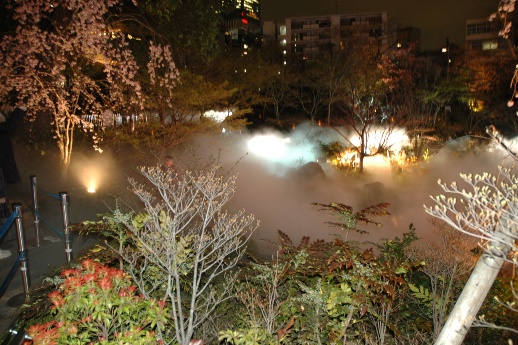
Fujiko Nakaya’s “Fog Garden #47662” was just that: the Mori garden was shrouded in a beguiling mist. Photo: WA

There was a matsuri-like atmosphere, with a plethora of stalls and eateries. Photo: WA
An Overview of Nouveau Graffiti
Graffiti is not your grandma’s tag anymore! Urban artists and interventionists are finding more and more ways to alter our environment without all the messy side effects!
Reverse Graffiti
“Reverse graffiti also known as clean tagging, dust tagging or grime writing, is a method of creating graffiti on walls or other surfaces by removing dirt from a surface. It is usually done by removing dirt/dust with the fingertip(s) from windows or other dirty surfaces, as in the old joke of writing “wash me” with one’s finger on a dirty car.” http://en.wikipedia.org/wiki/Reverse_graffiti
The Reverse Graffiti Project and artist Paul “Moose” Curtis create a poignant scene in SF. Watch the process in this short clip by director Doug Pray.
Moss Graffiti
I am particularly fond of this new method of beautification. An extension of the seed bomb artists are taking to the street armed with a blended recipe of moss and buttermilk. What results is living breathing art!
L.A.S.E.R Tag & Projection Art
There is almost too much to cover here and it just about warrants a whole new post. To wet your whistle check out these sites and projects.
The work of Graffiti Research Labs is stretching street art to new heights and takes a serious approach to including innovative technologies into everyday life. One recent project is L.A.S.E.R tagging.
Here is a great video of the process and a variety of tags.
Check out the Muonics blog for L.A.S.E.R tag code – its open source!
Another one of my very favorite group of innovators is MAW (Minneapolis Art on Wheels). Call me hometown proud. Watch them on Make television.
And last but not least for those of you looking for an excuse to go to Florida this summer Alys Beach should be your destination of choice. The second annual Digital Graffiti Festival will be held on June 6th 2009.
Mapping architectural facades made easy(web)
via It’s Tea
“3D Mapping Video projected creates a single event using the innovativing system that consists in applying video onto a monumental architecture or object playing with its forms and its volumes.”
http://www.easyweb.fr/indexenglish.html
I guess the lack of information, at least in English, is intended to make the potential client think it is magic that only Easyweb can deploy, and not think about the erasure of message into style, especially when compared to its its pioneering antecedents (which look oddly familiar), or how soon the technology will become commonplace and/or replaced by the next next thing.
Still, it’s cool.
Strut and fret your hour upon the plinth
Antony Gormley on the Fourth Plinth from One & Other on Vimeo.
via Artsblog
I don’t entirely trust Anthony Gormley’s rhetoric, but I admire his handler’s scripting:
- “It’s about the democratization of art.”
- “In the end it doesn’t really matter who gets up on that thing.”
- “I’ve got an idea. You can make it real.”
Is this the end of participation? As in the logical end. The end where “it doesn’t really matter who gets up on that thing?”
Ok, ok. I’d love to strut and fret my hour upon the stage of the 4th plinth.
Other projects I might have liked to have participated in:
- Almost any Janet Cardiff project, but my first love was her Telephone Call at SFMOMA
- Carsten Holler’s Revolving Hotel Room at the Guggenheim
- rtMark’s hijacking of the Whitney Biennial was brilliant and formative
- Paul Sermon’s telematic projects: remarkably embodied for such “primitive” technology
- To have my picture snapped on Monica Studer & Christoph van den Berg’s Package Holiday
What about you?
LED fireworks
“Flash @ Hebburn by Charles Quick launched March 7, 2009. While the title is not the catchiest in the world, the image did catch my eye, and the backstory is interesting.
During the course of his research, Quick found out that during the heyday of the city of Hebburn, if you looked across the Tyne river, where the site is located, it would almost look like fireworks there was so much activity from arc welding at the shipyards to the Monkton Coke Works, which looked like it was on fire at night.
Quick’s final design evolved to consist of twelve 8.5 metre high columns arranged in a 3 x 4 grid with a distance of 8 metres between each column. Photovoltaic panels on the top power 1 meter high blue and white LED tubes mounted on the columns. The LEDs flash responsively to people waking by during the day and with a single 15-minute programmed sequence at night, which is evocative of Hebburn’s historical industries. 8 different flash sequences were designed with local Hebburn groups and are visible from across the river as far as Newcastle, Gateshead and Wallsend.
I haven’t been able to find any good video of the project, but there are photographs, background information, and an interview with the artist here.
Links
Photo gallery including historic photos of Hebburn and interview with artist Charles Quick via southyneside.info
flickr photoset
Curly’s Corner Shop, the blog!
Public art for public transport
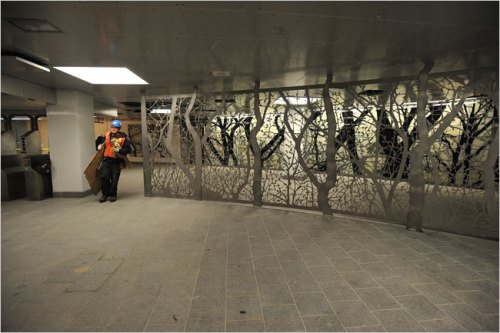
via Visualingual
Mike and Doug Starn’s See It Split, See It Change opened with the NYC South Ferry in January. From the entrance, a 20-foot wide, floor-to-ceiling marble mosaic map of the island of Manhattan extends down the stairs to the platform, inspired by an 1886 map of the tip of Manhattan from the United States Census Bureau. Curved floor-to-ceiling glass walls laced with silhouettes based on photographs of nearby Battery Park trees line the concourse. The installation is made from 425 glass panels that measure 14″ by 28″ each and includes many additional components.
Additional links
Caroline Cole, “See it Split, See it Change, and See it All for the Price of a Subway Ticket,” Metropolismag.com
Melena Ryzik, “Making Artistic Connections at a Subway Station,” NYT
Oliver Schwaner-Albright, “The New South Ferry Terminal: See It Split, See It Change,” Coolhunting
Miranda Siegel, “A Forest in the Subway,” New York Magazine
Starn Studio
Visualingual
See also
Behind Your Eye: Doug and Mike Starn via absolutearts
Uplifting art
Forecast annouces 2009 grantees!
Forecast Public Artworks, the 30-year-old independent public art agency, proudly announces its
19th round of grants to Minnesota artists for exploration of public art. Forecasts artist grants, funded by Jerome Foundation, annually support emerging and early career visual artists pursuing the public realm as a venue for creative expression. Funding was awarded to the following:
Category 1: Research & Development (2 @ $2,000)
Jane Powers
Jane Powers and Rita Davern will conduct research for their project Remember, a public art project to remember and honor Dakota people. Remember will provide a forum for reflection and dialog as we share our collective history. The artists will identify Dakota artists to collaborate on the project, research the history of the Dakota people in MN, and locate sites throughout Minneapolis and St. Paul for thought provoking and interactive visual and sound site markers.
Chris Pennington
Chris would like to create a billboard that is primarily an art object, an architectural marrying of a billboard, an office, and a 3D gallery…on a stick. Partnering with local architects he will explore all the various possibilities and applications of this idea and then create CAD drawings and a working model.
Category 2: Public Project (2 @ $7,000)
Anna Metcalfe
Anna Metcalfe and Grace Davitt will host weekly meals in the northside of Minneapolis using hand made plates and local produce. Expanding on weekly cookouts held at Redeemer Lutheran Church, Anna and Grace will infuse this tradition with locally grown, healthy foods and one of a kind, hand-made ceramic tableware. The weekly cookouts will give participants a chance to form connections with one another, the artwork and local produce.
Therese Kunz
Therese will work with Susan Ugstad to create A Lasting Piece: A Collective Collage, a large installation utilizing collage, voice, and light to showcase a visual narrative that speaks to the collective heart of their rural community. This project will be installed in an historic train depot in Remer, MN. The whole installation, built to travel, will be offered to other communities for exhibition including the creation of their own community collage to be installed at a site of their choosing.
Billboard Project ($3,000 design fee + installation costs)
Kao Lee Thao
Kao Lee will create a painted billboard design that speaks to the injustices of the remaining Hmong soldiers called Freedom Fighters from the “Secret War.â€Â Her airy gouache paintings are a contemporary reference to Hmong story cloths. Her design will be installed in mid summer on a billboard at University Avenue and Cleaveland Street in St. Paul.
Stay tuned for updates as these projects progress!
ID?
Does anybody know what this is?
Take from the 40th floor of the Wells Fargo Center in Minneapolis, facing east.
From agonism to the agoratic?
 I have to admit that ever since Warren Sack introduced me to some of Chantal Mouffe’s political philosophy with his game Agonistics: A Language Game, I have been enamored of the idea of agonistic pluralism. He wrote in his artist statement for Database Imaginary
I have to admit that ever since Warren Sack introduced me to some of Chantal Mouffe’s political philosophy with his game Agonistics: A Language Game, I have been enamored of the idea of agonistic pluralism. He wrote in his artist statement for Database Imaginary
In the 1980s, Chantal Mouffe and Ernesto Laclau had an idea: why not think about democratic discussion as a competition, an “agonistic” activity, a game? Society is recognized as impossible, as a space of endless contingencies. Establishing precise distinctions between difference and conflict, they articulated a democracy based not on hostilities where parties are enemies to each other, but on “agonism,” where parties are constructively adversarial. This theory accepts that democracy cannot be organized in a well-mannered way without room for confrontations and a multiplicity of voices.
It is an appealing vision: neither chaos nor hive mind but agonism.
In a fascinating essay, Public Art? Activating the Agoratic Condition, presented at the 48 Degrees Celsius Public.Art.Ecology festival in Delhi, Nancy Adajania, challenges
“Mouffe’s much-cited model of the public sphere, in which, as she says, “the aim of democratic institutions is not to establish a national consensus in the public sphere but to defuse the potential of hostility that exists in human societies by providing the possibilities for antagonism to be transformed into ‘agonism’.”
Adajania argues that
Mouffe’s theoretical sleight of hand is remarkably unhelpful when it comes to addressing the crises, dilemmas and the often schismatic turbulences that attend transitional societies, such as India, Sri Lanka, Pakistan, Turkey, Nigeria, Indonesia, Thailand, and South Korea, to name only a few. In these situations, the public domain is a scene for the battle among forces whose agenda commits them to mutual exclusion and sometimes even mutual annihilation. There is often radical disagreement on how to interpret the national past and the national future, on how to distribute power and authority, and what the nature of the State should be. In some of these situations, also, positions are taken on the basis of tactical opportunity and short-term gain rather than on that of long-held principle or reasoned conviction; where vote-bank politics, illiteracy, famine and cultivated regional asymmetries prevail, the ground of politics resembles a quicksand more than it does the floor of a debating room. As applied to such complex predicaments, Mouffe’s theories are about as useful as a Lego set to the building of metropolis.
Watching Republicans and Democrats in the U.S. Congress take remarkably antagonistic positions in the midst of a generational economic crisis, despite President Obama’s arguably agonistic vision of bipartisanship, one can’t help but think that agonism may not be Panglossian only in the “transitional societies” that Adajania cites.

Ravi Agarwal, Down and Out: Labouring Under Global Capitalism
In place of agonism, Adajania proposes the model of the agora:
the marketplace that is also a meeting place, a shifting weave of textures of thought, opinion, ideas and convictions; a non-hierarchical space of exchange where thought is multiplied and extended by distribution rather than imparted from a fixed source of authority. The agora of the classical Greek city-state was also, etymologically, the ‘open space’, where merchants, sailors, soldiers, artists, writers, priests, oracles, and madmen congregated and could voice themselves.
In “Public Art? Activating the Agoratic Condition,” Adajania sketches a nuanced idea of public art within an articulated notion of the public sphere and grounds her arguments in the specific artistic practice of two Indian artists, Navjot and Ravi Agarwal. Whether you buy Adajania’s agora or prefer to play agonisticly, Public Art? Activating the Agoratic Condition is a worthwhile read about experimenting wth art in public places.
Non- “FLOS” public space and aesthetic invention
Are the iPhone and iPod Touch new spheres for public art?
Bloom iPhone Application from Lawrence Brown on Vimeo.
The question is more than whether you like a particular aesthetic app on your device, such as Bloom or Buddha Machine, but how does the controlled space of the iPhone and iPod and their app store constitute a public sphere for artistic intervention?
Some might argue that as closed, legally controlled systems, the devices do not truly constitute “public space.” On the other hand, from Linda Benglis’s magazine ads to Giselle Beiguelman’s interactive billboard art to Dara Birnbaum’s Rio Videowall for an Atlanta shopping mall to the world-making in corporate controlled Second Life, there are numerous examples of important experiments by artists in legally constricted but nevertheless functionally public spaces. It is crtical, however, to always keep in mind that these spaces are not what one might call FLOS – Free/Libre/Open Source – spaces.
 Recently, Tiny Wonder Studios releaased Pixi for the iPhone and iPod touch. According to it website:
Recently, Tiny Wonder Studios releaased Pixi for the iPhone and iPod touch. According to it website:
“Tiny Wonder Studios is on a mission to create tiny miracles for the iPhone. Using nanotechnology, our patented “chaos processâ€, and very small screwdrivers, we lovingly craft the finest stuff for your mobile enjoyment.”
The first Tiny Wonder release is Pixi, which they “introduce:”
“Meet Pixi. Create infinite animated spirals of color and light by touching your screen. It’s magical. It’s mesmerizing. It’s music for your eyes. Pixi is simple to use, but you’ll find endless ways to express yourself the deeper you explore.”
Pixi is a bit like creating your own screensaver and can be mesmerizing, although, since I don’t use my iPod Touch as an ambient device – visually – it hasn’t, yet, migrated to my first screen of most-used apps.
In a conversation with Lawrence Bricker, a “film school graduate and lead geek” of Tiny Wonder Studios, he demonstrated a prototype version 2.0 that used the network to share Pixi creations and even locate nearby users in real time.
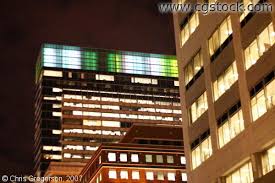 Personally, I’d like to see Pixi as a multi-storey display on the Target headquarters building in downtown Minneapolis and be able to modify it from my iPhone (which I plan to buy when Apple no longer forces me into a device-marriage with ATT, speaking of non-FLOS public space . . . ), like a Twin Cities version of Rafael Lozano-Hemmer’s Vectorial Elevation.
Personally, I’d like to see Pixi as a multi-storey display on the Target headquarters building in downtown Minneapolis and be able to modify it from my iPhone (which I plan to buy when Apple no longer forces me into a device-marriage with ATT, speaking of non-FLOS public space . . . ), like a Twin Cities version of Rafael Lozano-Hemmer’s Vectorial Elevation.
Mostly, however, Pixi makes me think of some kind of Moore’s law of aesthetic invention, where what decades ago Dan Sandin or John Whitney might have labored over for months or even years is now accessible in my pocket with the flick of a finger. That’s an interesting kind of progress, which like un-FLOS public space can’t simply be ignored.
via videosift.com
“In PERMUTATIONS, each point moves at a different speed and moves in a direction independent according to natural laws’ quite as valid as those of Pythagoras, while moving in their circular field. Their action produces a phenomenon more or less equivalent to the musical harmonies. When the points reach certain relationships (harmonic) numerical to other parameters of the equation, they form elementary figures.”
– John Whitney
Is it art or advertising? (Part I)
This is an easy game called “Is it art or advertising?”. Simply review the images and decide if you believe the projects shown to be art or advertising (or both).
Sometimes there may be only art, sometimes there may be only advertising, and sometimes one of each.
This game is inspired by the growing merger of aesthetics and commerce. As I realize that I am a targeted demographic for commercials using re-edited Roxy Music songs and Target ads that remind me of last years gallery shows, I begin to feel slightly uncomfortable. Is this is a mutually beneficial relationship for all involved? Is it bad to be inundated with higher level design and conceptual imagery on our billboards and buses even if its for corporate gain? What impact can public art projects have in taking over public spaces if their audiences can’t tell the difference between art and advertising? I can’t help but feel co-opted but maybe its just aesthetic evolution?







